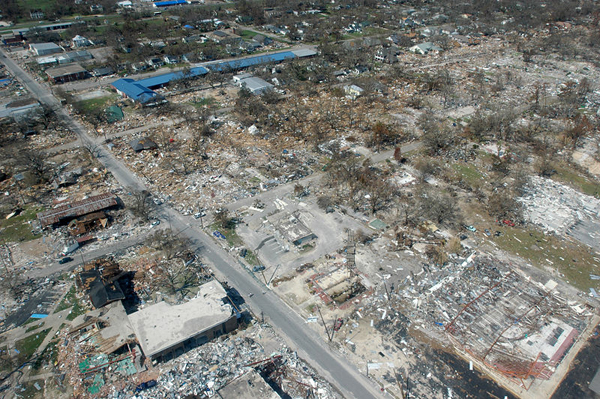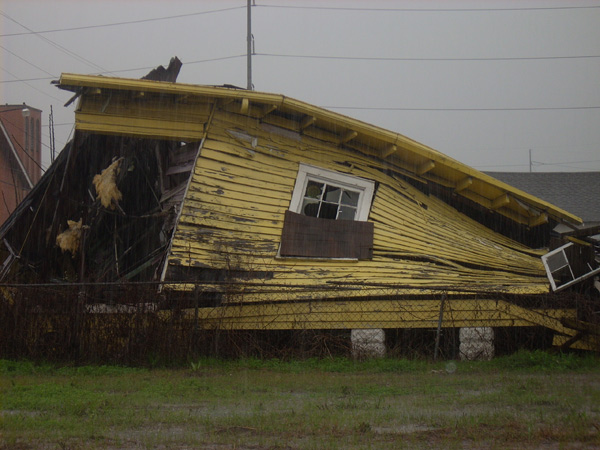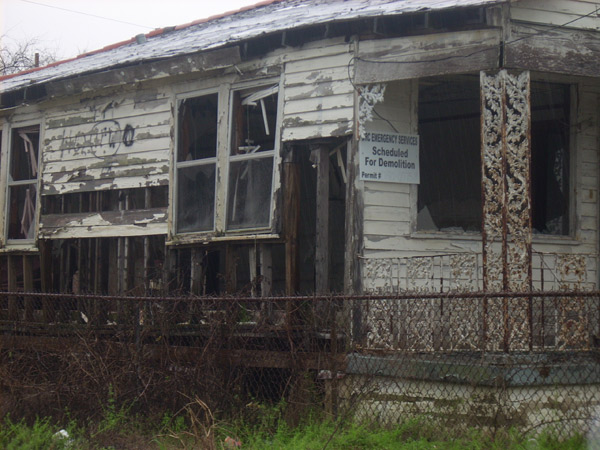SECTION 11
Hurricane Katrina
New Orleans, Louisiana in the aftermath of Hurricane Katrina, August 2005.
Source: AP Photo/U.S. Coast Guard.
In late August 2005, another kind of terror struck the African American community in the form of a massive hurricane. The areas most devastated by Hurricane Katrina were Louisiana, Mississippi and southwestern Alabama. By any standard, in terms of tens of billions of dollars in property damage and over one thousand lives lost, it was the largest natural disaster in U.S. history. The most heavily damaged major urban center that the storm affected was New Orleans, a city with an unrivaled historical tradition of black music and culture.
Destroyed houses in Gulfport, Mississippi.
Source: Federal Emergency Management Agency.
A house in the Lower 9th Ward of New Orleans in the aftermath of Hurricane Katrina.
Source: Megan French.
After the disaster struck New Orleans, President George W. Bush defensively argued that no one could have possibly anticipated the flooding experienced throughout much of the city, despite the fact that a number of scientists and investigative reporters had, for years, predicted that such a catastrophe was inevitable. But what made the New Orleans tragedy an “unnatural disaster” was the Federal government’s gross incompetence and indifference in taking the necessary measures to preserve the lives and property of hundreds of thousands of its citizens. The Federal Emergency Management Agency (FEMA), established in 1979, had been plagued for years with financial mismanagement, administrative incompetence, and cronyism. The litany of FEMA ’s bureaucratic blunders was amply documented: its insistence that vital supplies of food, water, and medical aid were impossible to deliver to thousands of people stranded at New Orleans’s downtown Morial Convention Center, though entertainers and reporters easily reached the site following the storm; its inability to rescue thousands of residents marooned on the roofs and in flooded houses for days; the failure to seek deployment of active duty troops in large numbers until three days after Hurricane Katrina struck the Gulf Coast region. But the incompetence went deeper than that. FEMA Director Michael Brown actually instructed fire departments in Louisiana, Mississippi, and Alabama not to send emergency vehicles or personnel into devastated areas unless local or state officials communicated specific requests for them – at a time when most towns and cities lacked working telephones, fax machines, and internet access. Florida’s proposal to send 500 airboats to assist rescue efforts was blocked by FEMA. Thousands of urgently needed generators, communications equipment, trailers, and freight cars of food went undelivered for weeks. Meanwhile, hundreds of dead bodies floated in New Orleans’s streets and rotted in destroyed houses.
Even before Hurricane Katrina struck, it was obvious that the overwhelming majority of New Orleans residents who would be trapped inside the city to face the deluge would be poor and working class African Americans, who comprised nearly seventy percent of the city’s population. As the levees collapsed and the city’s predominantly black Ninth Ward flooded, tens of thousands of evacuees were herded into the Superdome and Convention Center, where they were forced to endure days without toilets and running water, food, electricity, and medical help. Hundreds of black evacuees seeking escape on a bridge across the Mississippi River were confronted and forcibly pushed back into the city.
However, much of the media coverage cruelly manipulated racist stereotypes in its reports. In one well-publicized example, the Associated Press released two photographs of New Orleans residents wading through chest-deep water, carrying food obtained from a grocery store. The whites were described as carrying “bread and soda from a local grocery store” that they found; the black man pictured was characterized as having “loot[ed] a grocery store.” The flood of racialized images of a terrorized crime- engulfed city prompted hundreds of white ambulance drivers and emergency personnel to refuse to enter the New Orleans disaster zone. Television reports locally and nationally quickly proliferated false exposs about “babies in the Convention Center who got their throats cut” and “armed hordes” highjacking ambulances and trucks.
Nationally, most African-American leaders, public officials, and intellectuals were overwhelmed and outraged by the flood of racist stereotypes in the media, and their government’s appalling inaction to rescue thousands of poor black people. They observed that the most devastated sections of the city were nearly all-black and mostly poor. Local blacks had been largely ignored in preparations for evacuating the city. African Americans were stunned and perplexed by white America’s general apathy and denial about the racial implications of the Katrina catastrophe. Blacks were especially infuriated with the descriptions of poor black evacuees as “refugees” by government officials and the media. But the racial stigmatization of New Orleans’s outcasts forced many African Americans to ponder whether their government and white institutions had become incapable of expressing true compassion for the suffering of their people. For many African American leaders and citizens, white Americans’ blind refusal to recognize the racial dimensions of the tragedy in New Orleans illustrated just how deeply rooted racial injustice remained in America.
Related Resources
New Orleans, Louisiana in the aftermath of Hurricane Katrina, August 2005.
New Orleans, Louisiana in the aftermath of Hurricane Katrina, showing Interstate 10 at West End Boulevard, looking towards Lake Pontchartrain.
Source: AP Photo/U.S. Coast Guard.
A house in the Lower 9th Ward of New Orleans in the aftermath of Hurricane Katrina.
Source: Megan French.
Destroyed houses in Gulfport, Mississippi.
Gulfport, Miss., September 6, 2005 -- Hurricane Katrina caused extensive damage all along the Mississippi gulf coast.
Source: Federal Emergency Management Agency.
"Do Not Tear Down" sign on a house left behind by the owner.
Nearly a year after the storm, the Lower 9th Ward remained in ruins, with very little new housing available to those displaced by the storm.
Source: Megan French.
A House in New Orleans, Louisiana Destroyed by Hurricane Katrina.
Nearly a year after the storm, the Lower 9th Ward remained in ruins, with very little new housing available to those displaced by the storm.
Source: Megan French.







